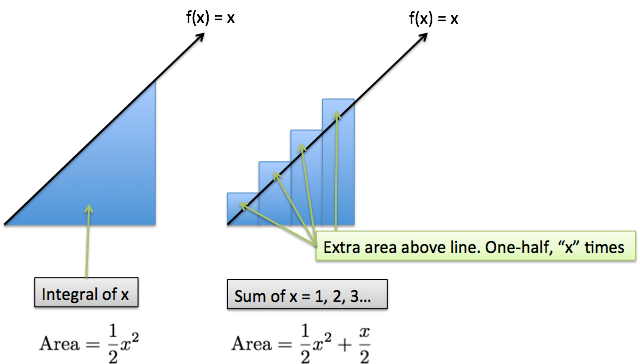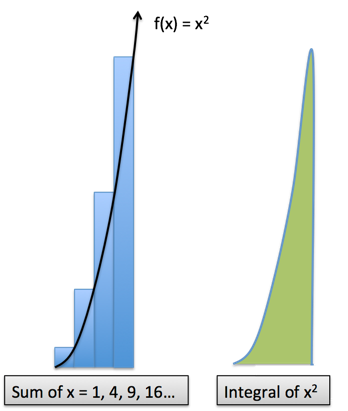Let's say you had to estimate 1 + 2 + 3 + 4 + 5 + 6 + 7 + ... + 100.
What would you do? Well, you could work out the exact formula:
![]()
and plug in n=100 to get 5050.
But we just want a rough answer. You have a list of numbers, they follow a simple pattern, and want a quick estimate. What to do?
The "easy" way (well, the Calculus way) is to realize 1 + 2 + 3 + 4 is about the same as $f(x) = x$. The first element is f(1) = 1, the second is f(2) = 2, and so on.
From here, we can take the integral:
![]()
We usually see the integral as a formal, elegant operation, which artfully accumulates one function and returns another. Informally, we're squashing everything together in that bad mamma-jamma and seeing how much there is.
The result $\frac{1}{2} x^2$ should be pretty close to what we want.

The exact total is our staircase-like pattern, which accumulates to 5050.
The approximate answer is the area of that triangle, $\frac{1}{2} base * height = \frac{1}{2} 100 * 100 = 5000$. The difference is because of the corners in the staircase which overhang. $\frac{x}{2}$ is one-half, x times (the size of overhang (1/2) times the number of pieces (x)).
The net result is using a smooth, easy-to-measure shape to approximate a jagged, tedious-to-measure one. (This is a bit of Calculus inception, since we usually use rectangles to approximate smooth shapes.)
More Estimates
This tactic works for other sequences:
What's the sum of the first 10 square numbers? 1 + 4 + 9 + 16 + 25 + ... + 100 = ?
Hrm. The formula is probably tricky to work out. But without our Calculus-infused Arithmetic, a quick guess would be:

![]()
Our first hunch should be "one third of 10^3" or 333. But as we saw before, there's an "overhang" that we missed. Let's call it 10%, for an estimate of 330 + 10% ~ 370.
The exact answer is 385. Not bad! The actual formula is:

I'd say $\frac{x^3}{3}$ isn't bad for a few seconds of work.
Data doubles every year. What does lifetime usage look like?
The integral (squashed-together total) of an exponential is an exponential. In Calculus terms,
![]()
The key insight is that all exponential growth is just a variation of $e^x$. If $e^x$ accumulates exponentially, so will $2^x$.
So the total usage to date will also follow an exponential pattern, doubling every year also. Contrast this with a usage pattern of "1 + 2 + 3 + 4 ..." -- we grow linearly ($f(x) = x$), but total usage accumulates quadratically ($\frac{1}{2}x^2$).
My goal is to incorporate math thinking into everyday scenarios. We start with an arithmetic question, convert it to a geometry puzzle (how big is the staircase?), and then use calculus to approximate it.
I know a concept is clicking when I can switch between a few styles of thought. Imagine the problem as a script: how would Spielberg, Tarantino, or Scorsese direct it? Each field takes a different look. (To learn how to think with Calculus, check out the Calculus Guide.)
Happy math.
Other Posts In This Series
- A Gentle Introduction To Learning Calculus
- Understanding Calculus With A Bank Account Metaphor
- Prehistoric Calculus: Discovering Pi
- A Calculus Analogy: Integrals as Multiplication
- Calculus: Building Intuition for the Derivative
- How To Understand Derivatives: The Product, Power & Chain Rules
- How To Understand Derivatives: The Quotient Rule, Exponents, and Logarithms
- An Intuitive Introduction To Limits
- Intuition for Taylor Series (DNA Analogy)
- Why Do We Need Limits and Infinitesimals?
- Learning Calculus: Overcoming Our Artificial Need for Precision
- A Friendly Chat About Whether 0.999... = 1
- Analogy: The Calculus Camera
- Abstraction Practice: Calculus Graphs
- Quick Insight: Easier Arithmetic With Calculus
- How to Add 1 through 100 using Calculus
- Integral of Sin(x): Geometric Intuition